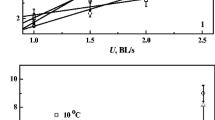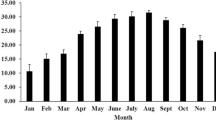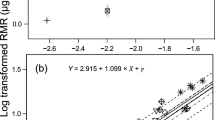Abstract
This study gives an integrated analysis of the effects of temperature, swimming speed and body mass on standard metabolism and aerobic swimming performance in vendace (Coregonus albula (L.)). The metabolic rate was investigated at 4, 8 and 15°C using one flow-through respirometer and two intermittent-flow swim tunnels. We found that the standard metabolic rate (SMR), which increased significantly with temperature, accounted for up to 2/3 of the total swimming costs at optimum speed (U opt), although mean U opt was high, ranging from 2.0 to 2.8 body lengths per second. Net swimming costs increased with swimming speed, but showed no clear trend with temperature. The influence of body mass on the metabolic rate varied with temperature and activity level resulting in scaling exponents (b) of 0.71–0.94. A multivariate regression analysis was performed to integrate the effects of temperature, speed and mass (AMR = 0.82M 0.93 exp(0.07T) + 0.43M 0.93 U 2.03). The regression analysis showed that temperature affects standard but not net active metabolic costs in this species. Further, we conclude that a low speed exponent, high optimum speeds and high ratios of standard to activity costs suggest a remarkably efficient swimming performance in vendace.



Similar content being viewed by others
Abbreviations
- AMR:
-
Active metabolic rate (J s−1)
- BL:
-
Body length (m)
- COT:
-
Cost of transport when swimming at Uopt (J m−1)
- M :
-
Fish mass (kg)
- net:
-
Refers to metabolic rate excluding SMR (–)
- SMR:
-
Standard metabolic rate (J s−1)
- T :
-
Temperature (°C)
- U :
-
Swimming speed (m s−1)
- U opt :
-
U associated with minimum costs (m s−1)
References
Akaike H (1974) A new look at statistical model identification. IEEE Trans Automat Contr AC19:716–723
Alexander RM (2005) Models and the scaling of energy costs for locomotion. J Exp Biol 208:1645–1652
Beamish FWH (1978) Swimming capacity. In: Hoar WS, Randall DJ (eds) Fish physiology. Academic, New York, pp 101–189
Beamish FWH (1990) Swimming metabolism and temperature in juvenile Walleye, Stizostedion vitreum vitreum. Environ Biol Fishes 27:309–314
Bejan A, Marden JH (2006) Unifying constructal theory for scale effects in running, swimming and flying. J Exp Biol 209:238–248
Bell WM, Terhune LDB (1970) Water tunnel design for fisheries research. Tech Rep Fish Res Board Can 195:1–69
Bernatchez L, Dodson JJ (1985) Influence of temperature and current speed on the swimming capacity of Lake Whitefish (Coregonus clupeaformis) and Cisco (C. artedii). Can J Fish Aquat Sci 42:1522–1529
Boisclair D, Tang M (1993) Empirical analysis of the influence of swimming pattern on the net energetic cost of swimming in fishes. J Fish Biol 42:169–183
Brett JR (1964) The respiratory metabolism and swimming performance of young sockeye salmon. J Fish Res Board Can 21:1183–1226
Brett JR (1965) The relation of size to rate of oxygen consumption and sustained swimming performance of sockeye salmon (Oncorhynchus nerka). J Fish Res Board Can 22:1491–1501
Brett JR, Glass NR (1973) Metabolic rates and critical swimming speed of sockeye salmon (Oncorhynchus nerka) in relation to size and temperature. J Fish Res Board Can 30:379–387
Brill RW (1987) On the standard metabolic rates of tropical tunas, including the effect of body size and acute temperature change. Fish Bull 85:25–35
Brown JH, Gillooly JF, Allen AP, Savage VM, West GB (2004) Toward a metabolic theory of ecology. Ecology 85:1771–1789
Childress JJ, Somero GN (1990) Metabolic scaling: a new perspective based on scaling of glycolytic enzyme activities. Am Zool 30:161–173
Claireaux G, Couturier C, Groison AL (2006) Effect of temperature on maximum swimming speed and cost of transport in juvenile European sea bass (Dicentrarchus labrax). J Exp Biol 209:3420–3428
Clarke A (2006) Temperature and the metabolic theory of ecology. Funct Ecol 20:405–412
Clarke A, Johnston M (1999) Scaling of metabolic rate with body mass and temperature in teleost fish. J Anim Ecol 68:893
Dabrowski K, Takashima F, Law YK (1989) Bioenergetic model for the analysis of the ontogenetical aspects of coregonid fish growth. Ecol Model 44:195–208
Dalla Via GJ (1983) Bacterial growth and antibiotics in animal respirometry. In: Gnaiger E, Forstner H (eds) Polarographic oxygen sensors. Springer, Berlin, pp 202–218
Day N, Butler PJ (2005) The effects of acclimation to reversed seasonal temperatures on the swimming performance of adult brown trout Salmo trutta. J Exp Biol 208:2683–2692
Dewar H, Graham J (1994) Studies of tropical tuna swimming performance in a large water tunnel––energetics. J Exp Biol 192:13–31
Dickson KA, Donley JM, Sepulveda C, Bhoopat L (2002) Effects of temperature on sustained swimming performance and swimming kinematics of the chub mackerel Scomber japonicus. J Exp Biol 205:969–980
Forstner H, Wieser W (1990) Patterns of routine swimming and metabolic rate in juvenile cyprinids at three temperatures: analysis with a respirometer-activity-monitoring system. J Comp Physiol B 160:71–76
Fry FEJ (1971) The effect of environmental factors on the physiology of fish. In: Hoar WS, Randall DJ (eds) Fish physiology. Academic, New York, pp 1–98
Gillooly JF, Brown JH, West.G.B., Savage VM, Charnov EL (2001) Effects of size and temperature on metabolic rate. Science 293:2248–2251
Gillooly JF, Allen AP, Savage VM, Charnov EL, West GB, Brown JH (2006) Response to Clarke and Fraser: effects of temperature on metabolic rate. Funct Ecol 20:400–404
Glazier DS (2005) Beyond the ‘3/4-power law’: variation in the intra- and interspecific scaling of metabolic rate in animals. Biol Rev Camb Philos Soc 80:611–662
Hammer C, Schwarz G (1996) The effect of prolonged swimming activity on the growth, proximate body composition and calorific content of O-age group whiting (Merlangius merlangus L, Gadidae). Arch Fish Mar Res 44:13–32
Helland IP, Freyhof J, Kasprzak P, Mehner T (2007) Temperature sensitivity of vertical distributions of zooplankton and planktivorous fish in a stratified lake. Oecologia 151:322–330
Hepher B (1988) Nutrition of Pond Fishes. Cambridge University Press, Cambridge
Herrmann J-P, Enders EC (2000) Effect of body size on the standard metabolism of horse mackerel. J Fish Biol 57:746–760
Hölker F (2003) The metabolic rate of roach in relation to body size and temperature. J Fish Biol 62:565–579
Hölker F (2006) Effects of body size and temperature on metabolism of bream compared to sympatric roach. Anim Biol 56:23–37
Jobling M (1994) Fish Bioenergetics. Chapman & Hall, London
Johnston IA, Temple GK (2002) Thermal plasticity of skeletal muscle phenotype in ectothermic vertebrates and its significance for locomotory behaviour. J Exp Biol 205:2305–2322
Korsmeyer KE, Steffensen JF, Herskin J (2002) Energetics of median and paired fin swimming, body and caudal fin swimming, and gait transition in parrotfish (Scarus schlegeli) and triggerfish (Rhinecanthus aculeatus). J Exp Biol 205:1253–1263
Lee CG, Farrell AP, Lotto A, MacNutt MJ, Hinch SG, Healey MC (2003) The effect of temperature on swimming performance and oxygen consumption in adult sockeye (Oncorhynchus nerka) and coho (O. kisutch) salmon stocks. J Exp Biol 206:3239–3251
McNab BK (2002) The physiological ecology of vertebrates: a view from energetics. Cornell University Press, Ithaca
Mehner T, Schulz M (2002) Monthly variability of hydroacoustic fish stock estimates in a deep lake and its correlation to gillnet catches. J Fish Biol 61:1109–1121
Muir BS, Newcombe CP (1974) Laboratory observations on filter feeding in atlantic mackerel, Scomber scombrus. Mar Ecol Lab
Myrick CA, Cech JJ (2000) Swimming performances of four California stream fishes: temperature effects. Environ Biol Fishes 58:289–295
Nagy KA (2005) Field metabolic rate and body size. J Exp Zool 208:1621–1625
Nelson JA, Gotwalt PS, Reidy SP, Webber DM (2002) Beyond U-crit: matching swimming performance tests to the physiological ecology of the animal, including a new fish ‘drag strip’. Comp Biochem Physiol A Mol Integr Physiol 133:289–302
Ohlberger J, Staaks G, van Dijk PLM, Hölker F (2005) Modelling energetic costs of fish swimming. J Exp Zool 303A:657–664
Ohlberger J, Staaks G, Hölker F (2006) Swimming efficiency and the influence of morphology on swimming costs in fishes. J Comp Physiol B 176:17–25
Oikawa S, Itazawa Y, Gotoh M (1991) Ontogenic change in the relationship between metabolic rate and body mass in a sea bream Pagrus major (Temminck and Schlegel). J Fish Biol 38:483–496
Pettersson LB, Hedenström A (2000) Energetics, cost reduction and functional consequences of fish morphology. Proc R Soc Lond B Biol Sci 267:759–764
Plaut I (2001) Critical swimming speed: its ecological relevance. Comp Biochem Physiol A Mol Integr Physiol 131:41–50
Robinson WR, Peters RH, Zimmermann J (1983) The effects of body size and temperature on metabolic-rate of organisms. Can J Zool 61:281–288
Schmidt-Nielsen K (1972) Locomotion: energy cost of swimming, flying and running. Science 177:222–228
Schulz M, Kasprzak P, Anwand K, Mehner T (2003) Diet composition and food preference of vendace (Coregonus albula (L.)) in response to seasonal zooplankton succession in Lake Stechlin. Arch Hydrobiol Spec Issues Adv Limnol 58:215–226
Schwarz G (1978) Estimating dimension of a model. Ann Stat 6:461–464
Somero GN, Childress JJ (1990) Scaling of ATP-supplying enzymes, myofibrillar proteins and buffering capacity in fish muscle: relationship to locomotory habit. J Exp Biol 149:319–333
Steinhausen MF, Steffensen JF, Andersen NG (2005) Tail beat frequency as a predictor of swimming speed and oxygen consumption of saithe (Pollachius virens) and whiting (Merlangius merlangus) during forced swimming. Mar Biol 148:197–204
Steinhausen MF, Andersen NG, Steffensen JF (2006) The effect of external dummy transmitters on oxygen consumption and performance of swimming Atlantic cod1327. J Fish Biol 69:951–956
Tanaka H, Takagi Y, Naito Y (2001) Swimming speeds and buoyancy compensation of migrating adult chum salmon Oncorhynchus keta revealed by speed/depth/acceleration data logger. J Exp Biol 204:3895–3904
Tang M, Boisclair D, Menard C, Downing JA (2000) Influence of body weight, swimming characteristics, and water temperature on the cost of swimming in brook trout (Salvelinus fontinalis). Can J Fish Aquat Sci 57:1482–1488
Taylor EW, Egginton S, Taylor SE, Butler PJ (1997) Factors which may limit swimming performance at different temperature. In: Wood CM, McDonald DG (eds) Global warming: implications for freshwater and marine fish. Cambridge University Press, Cambridge, pp 105–133
Tucker VA (1970) Energetic cost of locomotion in animals. Comp Biochem Physiol 34:841–846
Videler JJ (1989) Energetic consequences of the interactions between animals and water. In: Wieser W, Gnaiger E (eds) Energy transformations in cells and organisms. Georg Thieme Verlag, Stuttgart, pp 219–229
Videler JJ (1993) Fish Swimming. Chapman & Hall, London
Videler JJ, Nolet BA (1990) Cost of swimming measured at optimum speed: scaling effects, differences between swimming styles, taxonomic groups and submerged and surface swimming. Comp Biochem Physiol A 97:91–99
Ware DM (1978) Bioenergetics of pelagic fish: theoretical change in swimming speed and ration with body size. J Fish Res Board Can 35:220–228
Webb PW (1975) Hydrodynamics and energetics of fish propulsion. Bull Fish Res Board Can 190:1-159
Webb PW (1991) Composition and mechanics of routine swimming of rainbow trout, Oncorhynchus mykiss. Can J Fish Aquat Sci 48:583–590
Webb PW (1993) Swimming. In: Evans DH (ed) The physiology of fishes, pp 47–73
Weihs D (1973) Optimal fish cruising speed. Nature 245:48–50
Weihs D, Webb PW (1983) Optimization of locomotion. In: Webb PW, Weihs D (eds) Fish biomechanics. Praeger, New York, pp 16–32
West GB, Brown JH, Enquist BJ (1997) A general model for the origin of allometric scaling laws in biology. Science 276:122–126
White CR, Phillips NF, Seymour RS (2006) The scaling and temperature dependence of vertebrate metabolism. Biol Lett 2:125–127
Wieser W (1991) Physiological energetics and ecophysiology. In: Winfield IJ, Nelson JS (eds) Cyprinid fishes: systematics, biology and exploitation. Chapman & Hall, London, pp 427–455
Winberg GG (1961) New information on metabolic rate in fishes. J Fish Res Board Can Transl Ser 362:11 p
Zar JH (1996) Biostatistical analysis. Prentice-Hall, New Jersey
Acknowledgments
The authors wish to thank Thomas Mehner and two anonymous referees for helpful comments on an earlier draft of the manuscript. The experiments comply with the German Guidelines for Animal Care.
Author information
Authors and Affiliations
Corresponding author
Additional information
Communicated by G. Heldmaier.
Rights and permissions
About this article
Cite this article
Ohlberger, J., Staaks, G. & Hölker, F. Effects of temperature, swimming speed and body mass on standard and active metabolic rate in vendace (Coregonus albula). J Comp Physiol B 177, 905–916 (2007). https://doi.org/10.1007/s00360-007-0189-9
Received:
Revised:
Accepted:
Published:
Issue Date:
DOI: https://doi.org/10.1007/s00360-007-0189-9




